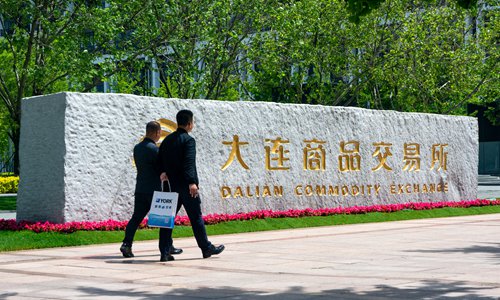
Investors walk pass Dalian Commodity Exchange in Dalian, Northeast China's Liaoning Province. (File photo: VCG)
As global commodity prices continued to plummet this week, Chinese analysts on Thursday suggested Chinese enterprises take advantage of trend to reduce costs of production in the second half of 2022, while warning over weakened demand and persistent challenges reflected by falling commodity prices.
Since June, commodity prices have fallen rapidly. Industrial metals are on track for the worst quarter since the 2008 financial crisis as prices are pummeled by recession worries. Crude oil price slump also deepened as demand concerns overshadow tight supplies, according to Bloomberg.
While the recent fall in global commodity prices is most likely temporary, it could still be beneficial for Chinese enterprises aiming to ramp up production in the second half of 2022, analysts noted.
"Enterprises should make good use of this short window and do some hedging operations to keep their production costs relatively low," Hu Qimu, chief research fellow at the Sinosteel Economic Research Institute, told the Global Times on Thursday.
Tian Yun, a Beijing-based economist, also said that lower commodity prices are certainly good news for China, especially as the country undergoes a huge infrastructure program in the third and fourth quarters to support growth.
However, declining global commodity prices also carry negative signs, analysts pointed out.
"The price drop itself reflects market pessimism about global growth, which is weak in terms of demand. Under such circumstances, even if upstream costs fall, the real economy will find it difficult to make profits in the face of shrinking demand, which is also a challenge that China faces in the second half of the year," Hu said.
There are two main factors affecting China's real economy in 2022 - rising raw material prices and weakened demand, analysts said. "COVID-19 flare-ups at home have dragged down demand. We need to be clear that Chinese demand has not fully recovered," Hu noted.
Uncertainties and destabilizing factors in China's foreign trade development have increased and the situation remains complex and grim in the second half of the year "due to geopolitical conflicts and accelerated monetary tightening in some developed economies, global economic growth may slow down, and the prospects for trade growth are not optimistic," Shu Jueting, a spokesperson for the Ministry of Commerce (MOFCOM), said on Thursday.
But she noted that MOFCOM and other departments will implement measures and policies to support consumption and foreign trade.
Signs of solid economic recovery have emerged since May. For example, industrial output in May expanded 0.7 percent year-on-year. In the first five months of the year, total industrial profits grew 1 percent year-on-year to 3.44 trillion yuan.


